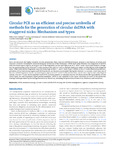Mostrar o rexistro simple do ítem
Circular PCR as an Efficient and Precise Umbrella of Methods for the Generation of Circular DsDNA With Staggered Nicks: Mechanism and Types
| dc.contributor.author | Ferro Gallego, Pedro Emilio | |
| dc.contributor.author | Vila-Sanjurjo, Antón | |
| dc.contributor.author | Valderrama Pereira, Andrea Katherine | |
| dc.contributor.author | Porres-Pérez, Gonzalo | |
| dc.contributor.author | Domínguez-Gerpe, María Lourdes | |
| dc.date.accessioned | 2025-01-03T12:51:45Z | |
| dc.date.available | 2025-01-03T12:51:45Z | |
| dc.date.issued | 2024-08-12 | |
| dc.identifier.citation | Pedro Ferro-Gallego, Antón Vila-Sanjurjo, Andrea Katherine Valderrama Pereira, Gonzalo Porres Pérez, Lourdes Domínguez-Gerpe, Circular PCR as an efficient and precise umbrella of methods for the generation of circular dsDNA with staggered nicks: Mechanism and types, Biology Methods and Protocols, Volume 9, Issue 1, 2024, bpae051, https://doi.org/10.1093/biomethods/bpae051 | es_ES |
| dc.identifier.issn | 2396-8923 | |
| dc.identifier.uri | http://hdl.handle.net/2183/40607 | |
| dc.description.abstract | [Abstract] Here, we introduce the highly versatile circular polymerase chain reaction (CiPCR) technique, propose a mechanism of action, and describe a number of examples demonstrating the versatility of this technique. CiPCR takes place between two fragments of dsDNA with two homologous regions, as long as one of the fragments carries said regions at its 3′- and 5′-ends. Upon hybridization, elongation by a polymerase occurs from all 3′-ends continuously until a 5′-end is reached, leading to stable circular dsDNA with staggered nicks. When both dsDNA fragments carry the homology at their 3′- and 5′-ends (Type I CiPCR), all four 3′-ends effectively prime amplification of the intervening region and CiPCR products can function as template during the reaction. In contrast, when only one of the two dsDNA fragments carries the homologous regions at its 3′- and 5′-ends and the other carries such regions internally (Type II CiPCR), only two 3′-ends can be amplified and CiPCR products possess no template activity. We demonstrate the applicability of both CiPCR types via well-illustrated experimental examples. CiPCR is well adapted to the quick resolution of most of the molecular cloning challenges faced by the biology/biomedicine laboratory, including the generation of insertions, deletions, and mutations. | es_ES |
| dc.description.sponsorship | This work was supported by the Ministerio de Sanidad, Consumo y Bienestar of Spain [FIS PI041740 to L.D.G.] and the Dirección Xeral de I + D+I of the Xunta de Galicia, Spain [PGIDIT05PXIC20807PN to L.D.G]. L.D.G. and P.F.G. received support from the Dirección Xeral de I + D+I of the Xunta de Galicia, Spain [L.D.G. under the Isidro Parga Pondal Program, and P.F.G. under the María Barbeito Program]. A.V.S. was supported by the Marie Curie Actions programme of the European Commission (Grant PIIF-GA-2010-274660) and by Xunta de Galicia via grant ED431B 2024/23 (GPC). Funding for open access charge: Consorcio Interuniversitario do Sistema Universitario de Galicia (CISUG) | es_ES |
| dc.description.sponsorship | Xunta de Galicia; PGIDIT05PXIC20807PN | es_ES |
| dc.description.sponsorship | Xunta de Galicia; ED431B 2024/23 | es_ES |
| dc.language.iso | eng | es_ES |
| dc.publisher | Oxford Academic | es_ES |
| dc.relation.uri | https://doi.org/10.1093/biomethods/bpae051 | es_ES |
| dc.rights | Atribución 4.0 Internacional | es_ES |
| dc.rights.uri | http://creativecommons.org/licenses/by/4.0/ | * |
| dc.subject | CiPCR | es_ES |
| dc.subject | Seamless cloning | es_ES |
| dc.subject | Circular-nicked dsDNA | es_ES |
| dc.subject | PCR cloning | es_ES |
| dc.subject | Site-directed mutagenesis | es_ES |
| dc.subject | Ligation independent cloning | es_ES |
| dc.title | Circular PCR as an Efficient and Precise Umbrella of Methods for the Generation of Circular DsDNA With Staggered Nicks: Mechanism and Types | es_ES |
| dc.type | journal article | es_ES |
| dc.rights.accessRights | open access | es_ES |
| UDC.journalTitle | Biology Methods and Protocols | es_ES |
| UDC.volume | 9 (2024) | es_ES |
| UDC.issue | 1 | es_ES |
| UDC.startPage | bpae051 | es_ES |
| dc.identifier.doi | 10.1093/biomethods/bpae051 | |
| UDC.coleccion | Investigación | es_ES |
| UDC.departamento | Bioloxía | es_ES |
| UDC.grupoInv | Grupo de Investigación en Bioloxía Evolutiva (GIBE) | es_ES |
| UDC.institutoCentro | CICA - Centro Interdisciplinar de Química e Bioloxía | es_ES |
| dc.relation.projectID | info:eu-repo/grantAgreement/MSC/Plan Nacional de I+D+i 2004-2007/04%2F1740/ES/ESTUDIOS ESTRUCTURALES, FUNCIONALES Y GENETICOS DEL TRANSPORTADOR 8 DE MONOCARBOXILATOS (MCT8) ESPECIFICO DE HORMONAS TIROIDEAS/ | es_ES |
| dc.relation.projectID | info:eu-repo/grantAgreement/EC/FP7/274660 | es_ES |
Ficheiros no ítem
Este ítem aparece na(s) seguinte(s) colección(s)
-
Investigación (FCIE) [1259]






